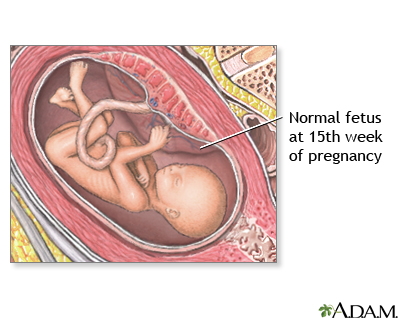- Your Baby: The Start of Thumb Sucking
At this stage, your fetus weighs about 1.75 ounces (50 g) and measures just over 4 inches (10.2 cm). Hair is sprouting everywhere. The fetus gets fine hair all over (called lanugo) to protect it from the amniotic fluid. Skin formation is ongoing, but is very thin (you can even see small blood vessels forming underneath). At this point, the baby might even be sucking its thumb.
- Your Body: The ABCs of MMS
What is an MMS?
The MMS, or multiple marker screen, is a blood test that measures the levels of certain biochemicals in the mother's blood. The test is often called the quadruple screen. It usually includes 4 biochemicals:
- Maternal serum alpha-fetoprotein
- Human chorionic gonadotropin (hCG), a hormone produced in the placenta
- Inhibin A, a hormone
- Unconjugated estriol, an estrogen produced by both the fetus and the placenta
A test for maternal serum alpha-fetoprotein (MSAFP) can sometimes be done separately or alone to screen for neural tube defects.
Noninvasive prenatal testing (NIPT), which involves testing for fetal DNA in the mother's blood, is a newer method of screening. This method is more likely to be used if there is a higher risk of genetic abnormalities.
When is the test taken?
To get the most accurate results, the test should be done between 15 and 20 weeks after the first day of your last menstrual period.
What is the purpose of the test?
The MMS is to see if your fetus is at risk for having a chromosomal defect such as Down syndrome or at risk for a neural tube defect. Abnormal levels of AFP, both high and low, may indicate some sort of birth defect. A high level may indicate a neural tube defect (such as spina bifida). A low level could indicate Down syndrome.
How safe is it?
The blood test poses no harm to the mother or the fetus. The real risk is that a false-positive result may require further testing such as amniocentesis, a more invasive procedure.
How reliable are the results?
The MMS is a screening tool used to identify women at risk for fetal problems. It is a very sensitive test. It's important to know that a positive result doesn't mean your baby is abnormal. It just means that your baby's risk of Down syndrome is greater than 1 in 270, or more than 0.4%. When you get your result, your health care provider should tell you your estimated risk of Down syndrome. If it's 1 in 200, there's a 99.5% chance your baby is normal. Even if it's 1 in 10, there's a 90% chance your baby is normal. The only way to know for sure is to have an amniocentesis. This is a procedure that collects fluid from around the baby and checks for chromosome problems.
Sometimes, an abnormal result has nothing to do with a chromosome problem. Instead, it can be attributed to:
- Incorrect estimation of the age of the fetus
- Twins (both babies produce the substance)
- Diabetes
Be sure to review your results with your provider.
- On a Different Note: Seeing for Yourself
Depending on your circumstances -- and on your health insurance -- you might not get to see your little one on an ultrasound until midway through your pregnancy (around week 18 to 20). This is when you will have a detailed ultrasound of your baby to check all of the anatomy.
- Weekly Tip
Take the MMS or the MSAFP test on the early side of the window in case you get a false-positive or false-negative result, and need further testing. That way, you'll have plenty of time to get genetic counseling, do a more in-depth ultrasound, and get an amniocentesis, if you choose to do so.



